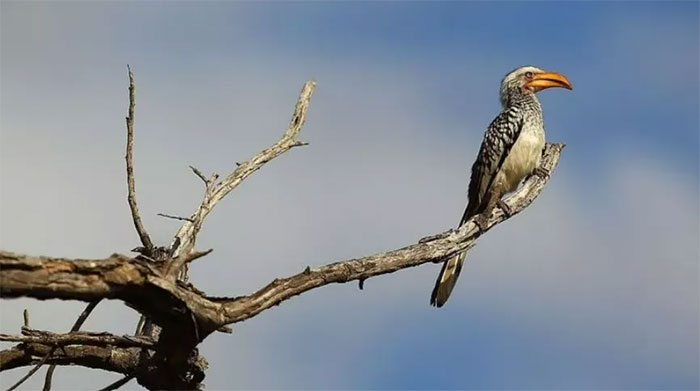The bird with colorful, very attractive plumage that appeared in the movie “The Lion King” and then became famous, is on the brink of extinction, wiped out by climate change.
Global warming is reducing the reproductive efficiency of the southern yellow-billed hornbill , a bird commonly found in dry forest and scrub areas in South Africa. During a hunting trip, you may encounter a yellow-red hornbill like the character Zazu from the movie The Lion King. In this animated musical, it is Simba’s most trusted advisor.
First author of the study, Dr. Nicholas Pattinson, University of Cape Town said that there is increasing evidence of the negative effects of high temperatures on the behavior, physiology, reproduction as well as survival of animals. birds, mammals and reptiles of the world. Heat-related mass die-offs over short periods of just a few days are increasingly being reported, which certainly pose a threat to population survival and ecosystem function. . Pattinson’s team studied a population of golden hornbills at the Kuruman River Reserve in the southern Kalahari Desert between 2008 and 2019. This data was collected exclusively from breeding pairs in nest boxes wooden.
 The effects of high temperatures have reduced the hornbill’s chances of breeding.
The effects of high temperatures have reduced the hornbill’s chances of breeding.
Similar phenomena have also been identified from analyzes of long-term trends and individual breeding efforts. Pattinson said that during the monitoring period, the lethal effects of high temperatures – including compromised feeding, provisioning and body mass maintenance – reduced the chances of successful reproduction. or even hornbill survival . These birds tend to be monogamous and live in breeding pairs or small family groups.
They have a very special cluck-cluck sound. When one bird begins to chirp, the whole group soon joins in to create a bustling symphony of bird calls. Its cries are also mixed with whistling, grumbling and grinding teeth.
This is one of the first major studies of the impact of the climate crisis on livestock success at a population scale over a longer period of time. Global warming is exacerbating the harshest conditions in the world’s driest regions, increasing the frequency and intensity of droughts. Animals living in these areas have suffered the consequences. Many bird species are affected, which breed earlier and in a shorter period of time.
There is increasing evidence of the negative effects of high temperatures on the behavior, physiology, reproduction and survival of various species of birds, mammals and reptiles around the world. . Mass mortality events certainly pose a threat to population survival and ecosystem function.
Golden hornbills are cavity nesters. The female locks herself up and stays there for an average of 50 days to incubate and care for her young after hatching. The male will feed the female and young through a narrow vertical opening. This type of nesting is a form of self-defense from predators, and reproductive success depends largely on other factors such as climate and food availability.
 The southern yellowbill could soon be wiped out by 2027.
The southern yellowbill could soon be wiped out by 2027.
Yellow-billed hornbills will begin breeding in response to rainfall, which corresponds to the hottest days of the year. This makes it difficult for them to change their breeding dates outside of the hottest times. When comparing the first three first seasons between 2008 and 2011 with the last three seasons between 2016 and 2019, the average proportion of nest boxes decreased from 52% to 12%.
Successful rearing and occurrence of at least one hatched bird decreased from 58% to 17%, and the average number of chicks born per breeding session decreased from 1.1% to 0.4%. . No successful breeding attempts have been recorded when air temperatures are above 35.7 degrees Celsius.
The hottest days have negative consequences for livestock production, and these effects appear even in years without drought. The findings highlight the rapid pace and severity at which the ongoing climate crisis is having devastating effects on particular species over alarmingly short time periods.
Current warming projections in areas where golden hornbills live suggest that the bird’s threshold for breeding success will be breached even during the rainy season around 2027. Much of the public perception them about the impacts of the climate crisis in relation to scenarios calculated for 2050 and beyond. However, the impacts of the climate crisis are still present and can manifest not only in a certain period of time but even over several generations of human life.

Although no major major mortality events have been recorded, projections in this study suggest that southern yellowbills could be wiped out from the hottest parts of their range as early as 2027. This outcome could lead to local extinctions, directly caused by no new baby birds joining the population, and would change the ecosystems on which we depend.





